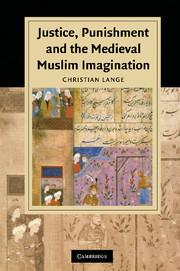Book contents
- Frontmatter
- Contents
- Acknowledgments
- List of abbreviations
- Introduction
- PART I THE POLITICS OF PUNISHMENT
- PART II THE ESCHATOLOGY OF PUNISHMENT
- 3 The structure of hell
- 4 Hell's creatures and their punishments
- PART III LEGAL DIMENSIONS OF PUNISHMENT
- Conclusion
- Bibliography
- Index of names
- Index of subjects
- Cambridge Studies in Islamic Civilization
4 - Hell's creatures and their punishments
Published online by Cambridge University Press: 21 July 2009
- Frontmatter
- Contents
- Acknowledgments
- List of abbreviations
- Introduction
- PART I THE POLITICS OF PUNISHMENT
- PART II THE ESCHATOLOGY OF PUNISHMENT
- 3 The structure of hell
- 4 Hell's creatures and their punishments
- PART III LEGAL DIMENSIONS OF PUNISHMENT
- Conclusion
- Bibliography
- Index of names
- Index of subjects
- Cambridge Studies in Islamic Civilization
Summary
Hell's angels
Having laid out the physical structure of hell, let us begin to fill this imaginary landscape with the unlucky creatures that populate it. Unlike in the Christian tradition, evil demons are punished in hell along with humans (Qurʾān 26:94–5), and Iblīs is not the Lord of Hell, but rather its most famous inmate. The “guardians of hell [khazana],” on the other hand, are angels. They guard the gates of hell (39:71) and are set to watch over the fire (74:31). Whether the zabāniyya mentioned in Qurʾān 96:18 are identical with the khazana is doubtful. However, in the exegetical tradition as well as the popular imagination, the identification was readily assumed. The Qurʾān (74:31) affirms that there are nineteen guardians of hell but at the same time declares that God has made their number “a stumbling block for those who disbelieve.” This has indeed proven a stumbling block, and not only for unbelievers. How could nineteen angels simultaneously manage to punish the myriad sinners in hell? Qurṭubī relates a discussion involving the early authority Abū l-ʿAwwām. “Who are the nineteen?” a man asks Abū l-ʿAwwām. “Nineteen thousand angels, or nineteen angels,” answers the traditionist, who is not so sure himself. “No,” the man corrects him, “they are nineteen.” Abū l-ʿAwwām, realizing his mistake, quickly concurs: “Correct, they are nineteen, each one of them has in his hands a bifurcated iron rod [mirzabba lahā shuʿbatān].”
- Type
- Chapter
- Information
- Justice, Punishment and the Medieval Muslim Imagination , pp. 139 - 176Publisher: Cambridge University PressPrint publication year: 2008



